#Synthetic Dyes/Pigments
Text
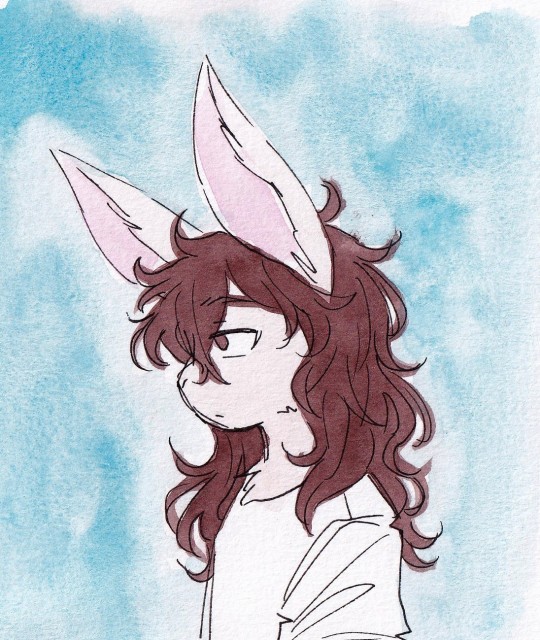
w
#art#traditional art#watercolour#oc art#ocs#oc group: ea#oc: unnamed#really do love using that one blue#i bought it in a local art supply store clearance bin misremembering how pigments work#(remembered i needed a green toned blue. vaguely remembered that my old blue was a cerulean blue hue)#(bought this. an actual cerulean blue which behaves vastly differently from the synthetic hue)#it was technically a mistake but its my favourite mistake 'cause this pigment is NUTS#granulation i think is the term. it gets to textury and behaves so erractically its awesome#thats why i love using it for BGs LOL#especially since im usualy painting on my cheap sketchbook paper and it like#sinks into all the irregular cellulose fibres so nicely#i imagine on cotton it would look just as wild but in a different way#very fun what some pigments and dyes will do in certain circumstances
7 notes
·
View notes
Text

Ajanta Colours is a leading company in the colours manufacturing industry with more than 75+ years of market presence. We have 5 eco-friendly manufacturing plants to meet the demands of our clients across the 6 continents. Our premium and high-quality colourants are highly demanded in various industries such as foods, beverages, cosmetics, sweets/mitha, chocolates, inks, pharmaceuticals, animal feed, confectionery, bakery, home care, agriculture, biscuits, desserts, personal care products, and many more.
1 note
·
View note
Text
dyes Intermediate Manufacturer
Natraj Chemicals , Paabsa Exporter
#acid dyes#chemical & dyes news#chemical suppliers#export from india#dye sublimation perth#manufacturing#dyes and pigments companies#chemical industry#dyestuff#synthetic dyes market#basic dyes#dyes and pigments market
0 notes
Text
Plastic waste breaks down over time into nanoplastics (<0.1 μm). Microplastics smaller than 20 μm cannot be removed in currently operating water treatment plants and must be agglomerated to a larger size and then removed. Iron (Fe) or aluminum (Al) based flocculants are used for this purpose, but they are not the ultimate solution as they remain in the water and cause severe toxicity to humans, requiring a separate treatment process.
Dr. Jae-Woo Choi of the Center for Water Cycle Research at the Korea Institute of Science and Technology (KIST) has developed an eco-friendly metal-organic skeleton-based solid flocculant that can effectively aggregate nanoplastics under visible light
irradiation. The research was published in Water Research.
Prussian blue, a metal-organic frameworks-based substance made by adding iron (III) chloride to a potassium ferrocyanide solution, is the first synthetic pigment used to dye jeans a deep blue color and has recently been used to adsorb cesium, a radioactive element, from Japanese nuclear plant wastewater.
Continue Reading.
192 notes
·
View notes
Text
I didn't want to give too much weight to Hiiragi's tarot reading schtick. Yet, it's an author insert moment, and Kaneshiro loves foreshadowing. I have a worrying feeling that these fortunes may hold true for Chigiri, Barou and Nagi.
Full disclosure: I know very little about tarot, but did some high level reading through Wikipedia and other sources.
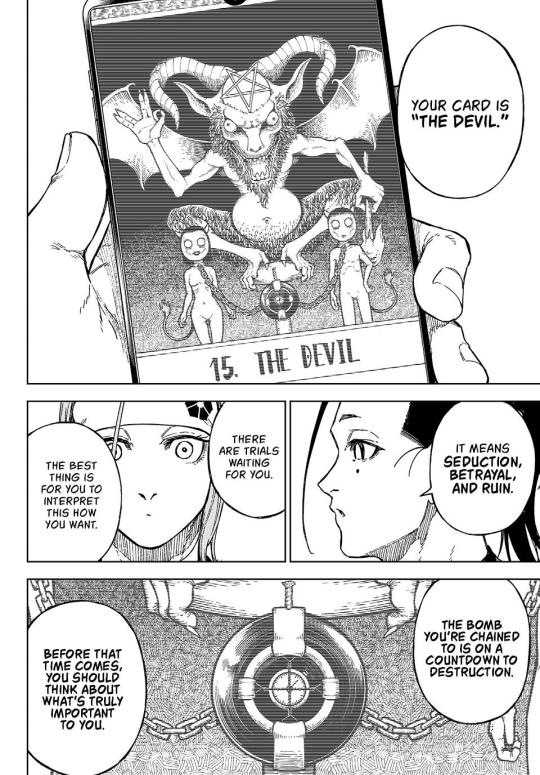
Chigiri gets the 15th card of the Major Arcana, the Devil. In the official translation, Hiiragi notes this to represent seduction, betrayal and ruin. Oof.
The obvious connection is to Chigiri's leg—the fortune could be tied to how he was seduced by football, became addicted to it, but will subsequently be betrayed by his leg... leading to ruin.
The Devil tarot card doesn't normally show a bomb, so this is for dramatic effect. Thematically, it implies that Chigiri should find purpose (or know where to seek it) beyond football, ahead of the day his luck runs out. 🥺 Not the outcome I want for our princess, but a second ACL injury has long been speculated by fans. Chigiri himself is aware that it's a risk when playing at this level.

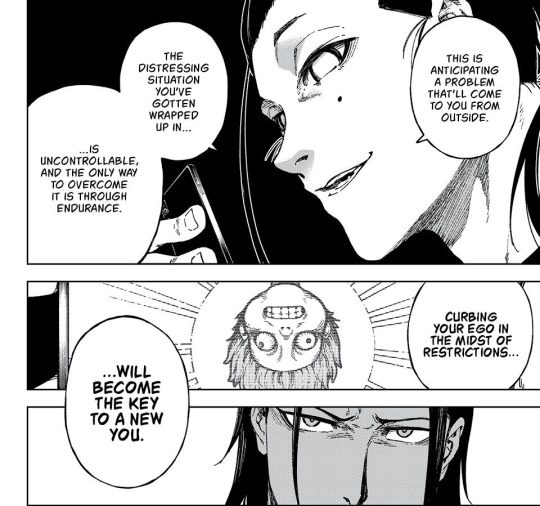
Barou chooses number 12, the Hanged Man. Hiiragi cherry-picks his interpretation; in addition, this card is associated with motifs of self-sacrifice, learning, and change in perspective. It can also be interpreted as a voluntary state, rather than something that befalls a person.
It's a good fit for Barou, who doesn't double down on his ego so much as grow to show why he's deserving of his nickname in the first place. Barou is a king on the pitch, and expects a level of servitude from his teammates, but not without constantly improving his own skills and talent. He's no lazy despot, though despot he may be.



The Hanged Man fortunes supports his emotional outburst during the Ubers match. Barou remarks that he needs the challenge of despair to grow. As such, the trials he puts on himself are deliberate, much like the tarot reading suggests.


Nagi gets #13, Death (because of course he does). This fortune seems to be the most thoughtful of the bunch, unsurprisingly. Hiiragi's interpretation, while intended to provoke Nagi above all, holds up well against what little I've read on tarot.
The Wikipedia page for the Death arcana had some additional nuggets of insight, or rather further ammunition for those of us manifesting a second NagiReo divorce:
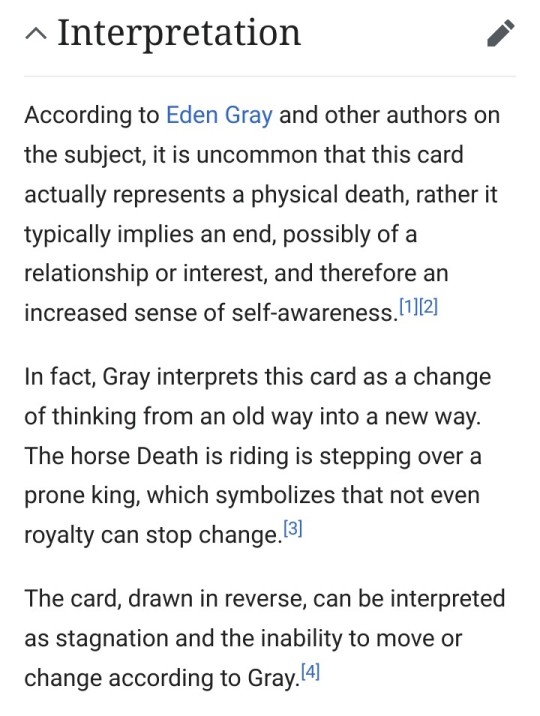
Reo is frequently referred to as princely and compared to royalty in the series, with his superfluous wealth and the way he confidently takes on leadership roles among teams. His signature colour, purple, has monarchial associations due to how rare and expensive purple pigments are in nature (prior to the invention of synthetic dyes).
Of course Reo, this royal youth, opposes Nagi's desire to change... seemingly at every hurdle.
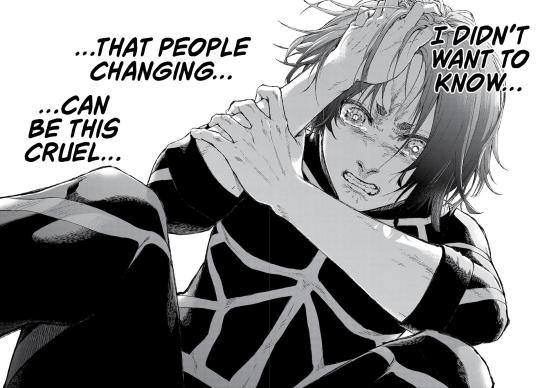
It's not deliberate sabotage though, more that they're hamstrung by their co-dependency. Unlike almost every other relationship in Blue Lock, which arose from rivalry or a shared desire to improve, Nagi and Reo's friendship is rooted in the naive promises they made before entering the programme. @thyandrawrites had a great post exploring this recently, which I recommend if you want to delve deeper into the reasons for their underperformance in the Neo Egoist league.
My take is, in essence, if these two could agree to remain friends while moving away from being inseperable on the pitch, they'd both flourish.
Back to tarot: Wikipedia also has a tidbit on reversed cards, which I understand aren't a hardwired aspect of reading tarot (it refers to physical cards that are revealed upside down after being shuffled and dealt). The interpretation Wikipedia gives of an inverted Death card is reminiscent of Nagi's status after he plays against Isagi and Bastard München.
In short: Nagireo bad for one another, and Nagi will undergo quite the metamorphosis in his journey through Blue Lock, if this fortune holds.
---
Analysis aside, I wouldn't put too much faith into what these fortunes mean for the characters. Tarot itself isn't immutable, and for every motif listed above, the characters also have other tropes influencing the paths they take. For example, Chigiri shares the whole hero/princess trope with Kunigami, which has more plot significance than his leg injury at present. Nagi embodies the role of a natural prodigy who has neither the knowledge or experience to deploy his talents consistently. Barou embodies an villain or anti-hero archetype, when juxtaposed with Isagi. Each character has more to the eye than a simple playing card can reveal which is why I'm here yapping at length about them during my lunch break
#blue lock#blue lock manga#bllk#bllk manga#episode nagi#epinagi chp 19#hiiragi reiji#chigiri hyoma#baro shoei#nagi seishiro#mikage reo#blue lock analysis#bllk analysis#boinin talks bllk
103 notes
·
View notes
Text
Researchers at Imperial College London have genetically engineered bacteria to grow animal- and plastic-free leather that dyes itself.
In recent years, scientists and companies have started using microbes to grow sustainable textiles or to make dyes for industry -- but this is the first time bacteria have been engineered to produce a material and its own pigment simultaneously.
Synthetic chemical dyeing is one of the most environmentally toxic processes in fashion, and black dyes -- especially those used in colouring leather -- are particularly harmful. The researchers at Imperial set out to use biology to solve this.
In tackling the problem, the researchers say their self-dyeing vegan, plastic-free leather, which has been fashioned into shoe and wallet prototypes, represents a step forward in the quest for more sustainable fashion.
Read more.
39 notes
·
View notes
Note
Hello! I love your blog bc it helps me a lot with writing and crafting. Thank you so much for making it!
Are there any patterns that deal with poison? Either in the pattern or in the dyeing process?
Even if there's not I'm glad you and this blog exist 💗
(anon continues) Poison in the dyeing process, like when green dresses were dyed with copper arsenite and it was extremely deadly.
Or a pattern of someone being poisoned, like a historical/folktale.
_______________________________________
Thank you for your kind words <3 I tried to keep things organized but the subject is huge so my of the top of my head answer is going in many directions. I hope you'll still find what you need :3
I'll briefly cover here dyes and (pigments), poison motifs, real life and supernatural poisonings. Buckle up we've got a long post ahead!
____ ABOUT DYE
Tbh I had to think for a moment because I don't recall major "poison" stories linked to dyes in Japan, be it fictionous or real (yet that doesn't mean none ever happened, especially considering Japan's history of industrial poisonings...).
Most gruesome details in the fabric industries I know of are about the horrific life & work conditions of female laborers in spinning mill manufactures (as in many countries, Japan industrialization process was ghastly...).
If potters and dyers had excellent practical knowledge, chemistry as a science officially started kind of late in Japan as it was not a local interest, and as rangaku (study of Western knowledge) often favored other subjects like medicine or warfare.
So, until the introduction of aniline dyes (not textile related, but this article about the use of synthetic dyes in ukiyoe printing is super interesting), Japanese worked with "natural" dyes, like ai (indigo) which was the most used during Edo period.
As with any ingredient, being natural doesn't equal safety. Some mixtures could be quite potent/foul, and process could be dangerous. Plants and minerals base ingredients could be toxic (cinnabar and orpiments were then used as paint pigments, and lead could be found in make up), as were mordants used to set colors.
If you want to easily overview which ingredients were used to create colors, I recommand browsing [Irocore] which presents colors with explanation in English in their database (pick a color then scroll down).
Not related to poison, but ai (indigo) is traditionally prepared in aigame/enormous floor set jars I find utterly terrifying:
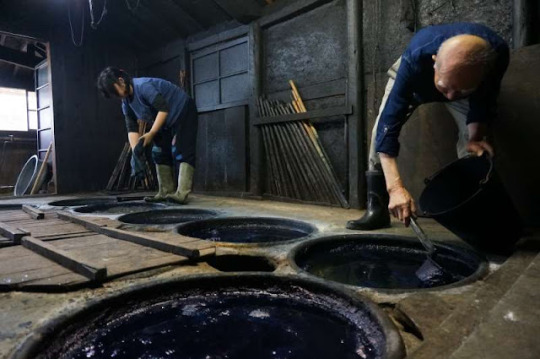
I don't know if this tidbit can help you, but some dyes and mordants actually damage the fabric overtime, leaving them brittle (silk desintegrates after a while which is a huge issue in textile conservation).
____ POISON MOTIFS
Concerning "poison" themed patterns, none would be actually used traditionally on a kimono or an obi beside novelty items ^^;
For example, many plants can be toxic, but I don't see them set as pattern for this property - they'd rather refer to a poem, be a symbol of the passing of seasons etc. Fuji (wisteria) can be quite harmful, yet it's a beloved traditional motif in Japan.
You have much more chances to find pattern with kujaku (peacock) which are thought to be impervious to poison in Buddhism, than say venomous mukade (centipede) or the horrific ômukade (a youkai I covered in a folktale).
Snakes like the habu and mamushi are dangerous, but if used as pattern snakes are most often auspicious and linked to rain dragons or goddess Benzaiten.
If you squint hard, toxic fugu could count as poison pattern, but such a seasonal delicacy as a motif would mostly underline wealth (as those fishes are pretty expensive as they are prepared by specialized chefs), a kind of carpe diem spirit, or just a fun pattern because fugu balloon shape is cute ;)
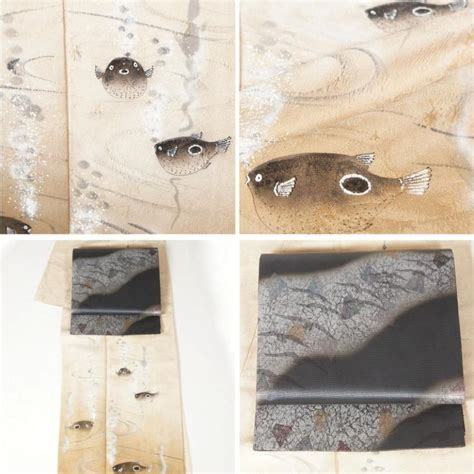
____ POISON MURDERS
Poisoning was certainly a thing is Japan since ancient times (see kodoku sorcery). Poisons were for example used in some fishing techniques.
I am pretty sure some kuge and buke were disposed of this way - even thought poison was seen as a coward weapon (hence why its supposed to be only used by shinobi/ninja - even if this "fact" is opened to a lot of discussions!).
During Edo period, such murders made up the news and penny dreadful-like illustrated books favored by city dwellers in need of a fright. But those stories didn't pass to posterity beside cheap ukiyoe plates, and were never as popular as some shinjû (double suicides) or ghost revenges like poor poisoned and murdered Oiwa's:
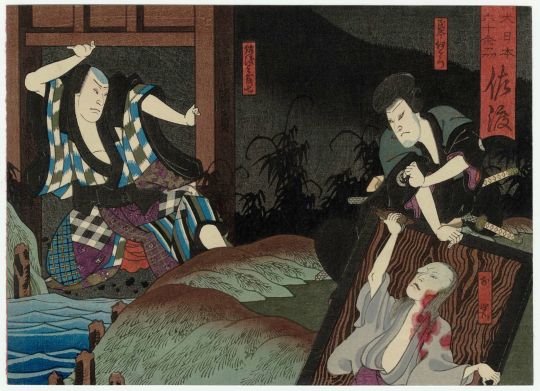
____ SUPERNATURAL POISONINGS
If your poison is both physical and metaphorical illbeing, mushi could be your guys ^^ This term actually covers everything small and crawling, from real worms and insects, to anything inside one's body causing distress - be it a parasite, an unknown illness, an overboard emotion, a curse etc. If you've read/seen Mushishi you've got what I mean:
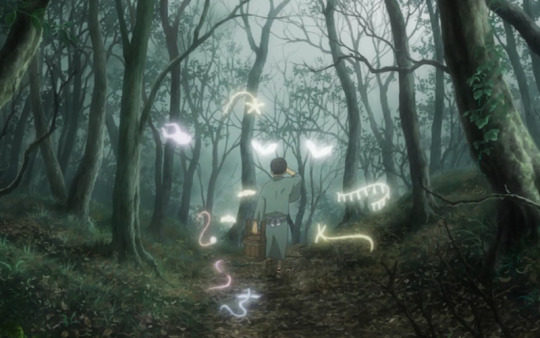
In fact any illness-causing being could count as poison-bringer. Hôsôkami (smallpox demon) was truly feared by all before vaccination was introduced in Japan.
Finally, continuing the supernatural poisoning trail, best girl is probably legendary fox witch Tamamo no Mae who among other terrible deeds made emperor Konoe fall sick with poisonous miasma (some version of the story attributes the disease to another monster, the nue). I covered a similar murderous kitsune folktale here.
#ask#japan#japanese history#dye#pattern#motif#poison#venomous#illness#natural dye#aniline dye#mordant#pigment#kujaku#peacock#mukade#centipede#omukade#youkai#snake#hebi#mamushi#habu#benzaiten#fugu#mushi#insect#mushishi#Hôsôkami#smallpox demon
109 notes
·
View notes
Text
Humans Body Decorations #2
Humans have colored their fingernails and fingertips in a myriad of colors for thousands of years using an assortment of pigments and dyes. In ancient times the coloring and intensity of nails signified status, or it was done for superstitious/religious purposes.
In modern times these customs have evolved into the art of sculpting synthetic nails out of resins and plastics and using a variety of paints, powders, and crystals to decorate said nails in elaborate designs.
101 notes
·
View notes
Note
Going off the inkcap into ink ask, apart from food and ink, what else can I do/make with fungus?
here's a little list !! :-)
with artist's conk brackets, you can use the underside for drawing as - when the flesh is scraped away - there is a brown layer underneath. when it dries & hardens the art will keep for a long time :-)
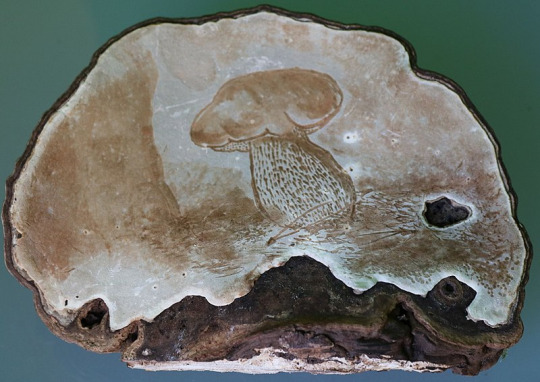
mushrooms that contain psilocybin are used as psychedelic drugs - the most potent is p. azurescens.

many different fungi can be used as dyes -
many moulds are used in food manufacturing processes, for example when making cheese or yoghurt.
you can purchase mycopesticides to control pests.
yeast is a fungus that we consume every day through beer, wine, soy sauce & bread products. :-)
that's about all i've got for you, luna !! <3
#• askbox replies: •#(ask : luminousmoon21)#[ganoderma applanatum]#: artist's palette :#: artist's fungus :#: artist's conk :#: artist's bracket :#: bear bread :#||#fungi#mould#mold#fungus#mycology#[psilocybe azurescens]
55 notes
·
View notes
Text
Acid Dyes In Squirt Bottles: kinda a tutorial
So I bought some silk scarves with an eye toward dyeing them to use for giftwrapping for Christmas, and I'd idly meant to research techniques but suddenly realized I'm running out of time.
Almost all the tutorials on dyeing anything at all that I can find lately are for ice dyeing. Which is cool and I love that that's so trendy now. But some of the ones I've watched...
Well, see the point of ice dyeing is that powdered dyes often split into components and so you get really cool edge-effects where the different pigments in the dye penetrate the fabric differently because of the slow wicking action of the melting ice etc. I watched a tutorial where someone just had three primary colors, which are generally pure pigments, and did this, and I was like, you could have put those into squirt bottles and saved yourself about 8 hours plus all the time you spent making that ice. It did give a nicely feathered spectrum effect but the ice mostly did not contribute anything to the process.
But what I did learn from that tutorial was some advice on how to get acid dyes to strike in a cold low-immersion process. So I'm going to write up what I did, since that's what I was actually looking for, and every bit of information I can currently find is contained in overly-long videos that spend most of their runtime on irrelevant stuff.
Mostly this is for my own reference later, as I'm now old enough that I keep stumbling across things I've made and being like "wait I don't remember how I did this. I really made this? I have to have, nobody else lives here. How did I do this??" So anyway, overly-long and underly-technical writeup below the cut. Pictures to follow in a separate post.
What do I mean, cold low-immersion process??
Immersion is how most dyeing works. You make a dye bath, and you dunk your fabric into it. Low-immersion means you lie your stuff all out on some flat surface, maybe over a wire rack maybe over a sheet of plastic, and just put enough dye on for it to soak in. That's low-immersion, and generally is how you're gonna get multiple unmixed colors on one object.
and cold? Well, acid dyes, which work best on protein-based fibers like wool and silk, need heat to strike, or actually bond to the fabric. If you just dunk some silk in a dye bath and then rinse it, the dye mostly rinses out. You need heat to set it.
Let's back up a second-- acid dyes?? So there are two main types of dyes you use on fabric. Acid dyes are called that because you add some vinegar once the dye has soaked in, to get it to stick. (Yes, you need acid and heat!) The other kind, which you usually use for ice dyeing, is fiber-reactive dyes. Fiber-reactive are what you want for cotton, linen-- plant-based fibers, and some synthetics. (Nylon works with acid dyes for some reason, rayon needs fiber-based. I don't remember why but the Internet surely knows, it's surely very simple.)
So anyway. Fiber-reactive dyes are applied to fabric that's been pre-treated with soda ash and then set without much heat, though they do need to "cure" at a high temperature-- it doesn't have to be as hot as with acid dyes though. (A black plastic bag in the sun, an electric blanket lying overtop the bag they're in, that level of heat at most.) So they're the usual, traditional type of dyes you use for tie-dyeing, which is normally done on cotton t-shirts, and which very often is done with low-immersion methods to let you get a bunch of colors on there, are fiber reactive dyes. Many many many tutorials exist for this, including how to tie them. Very cool stuff.
I wanted that effect on silk though.
(*the alkali pre-rinse is fine for cotton and linen and such. alkali on silk is Generally Bad News. This is another reason people generally don't do fiber reactive dyes on silk. Silk shrugs off acid reasonably well but alkali is no bueno. Also for the record never ever try to bleach silk for any reason, that dissolves it. Now You Know!)
So. I did find this tutorial from Dharma Trading, about space dyeing. Remember when space-dyed stuff was trendy?? Many of you whippersnappers probably don't. It used to be cool and is probably what led to the invention of ice-dyeing, which clearly like A Person invented but I have no idea who and I bet finding out would be difficult so my ADHD ass is NOT going down that rabbit hole right.
So i tried that. I used aluminum foil instead of plastic wrap for the simple reason that my kitchen is currently torn apart and all my worldly goods in cardboard boxes but I had a roll of aluminum foil in the basement for some reason. I put down a vinyl tablecloth on my washing machine and used it as a work surface. And I found a broken old steamer insert and set it in an old aluminum pot that lives in the basement.
I mixed up squirt bottles of four colors of acid dye in approximately the proportions from the Dharma tutorial. I don't have measuring implements currently, see above re: kitchen (I'm planning on retiring a number of my measuring implements to serve in fiber arts, and keeping only the nice ones for the new nice kitchen, but that hasn't happened yet) so it was all very approximate.
And then I just lay each silk scarf out on the aluminum foil on the dryer and went to town.
I learned to be careful and sparing with the amount of dyes, to keep them from pooling underneath the material-- silk scarves aren't very absorbent. Any excess dye pooling on the aluminum foil will of course spread and get muddy. So what I wound up doing was working from right to left (on my left was the laundry sink), and doing my lightest color on the right and my darkest on the left, and then when I was done, I used an eyedropper to apply white vinegar to lock in the pigment, and then I picked the whole works up very carefully and tipped it to the left and let everything extra run off into the sink. So having my, say, fuschia run across the back of what was supposed to be a dark purple section didn't lead to any notable color contamination. One colorway had bright lemon yellow in it, and I was incredibly careful not to let any smudges or drips touch that-- kept it on the right of my workspace, propped up slightly. The yellow draining across the red and purple of that colorway didn't cause a problem, but I did wind up with a fingerprint of darker color in the yellow area (I think that's what caused the blot anyway).
Anyway, once the dye was all applied, and I'd let it drip into the sink for a moment, I then folded up each scarf into its own packet, careful to still keep the lighter end upward, and put it into my busted-ass steamer basket which made this easier because one of the legs has fallen off it, see, so it tilts anyway, that's why I retired it, and put the lid on and steamed each packet for about half an hour to 45 minutes.
At the end of that I pulled each packet out (there were overlaps, where I'd put a second packet in halfway through the first one. Most of the Strict Rules About Steaming Silk don't apply to this process because drips aren't a problem, dips in temperature that might lead to uneven mottling aren't a problem, this is just meant to be pretty color splotches with random patterns so literally none of the intimidating stuff you have to do to achieve perfection are a problem here), I let it cool off a bit and then unwrapped it and rinsed the scarf. Not much color came off them, and I was able to reuse the foil, which it's not that I'm being eco-friendly so much as that I only had the one roll of foil with not much left on it and this was the last day I could really do this, so. Not very scientific, but in the end I really was very thrifty LOL. Yes! I was being eco-friendly, that's why i'm like this.
I then let the scarves dry on my drying rack overnight, and came back the next day to collect them. I brought them all back to my mother-out-law's to wash them in her washing machine since mine is currently not properly hooked up (additional nightmare, love it)-- I figured this wouldn't be messy in her impeccable laundry room and I was right, very little dye to rinse out. Gave them a wash with dharma's professional detergent, then a rinse with milsoft, then an extra rinse, and I've now let them dry again, ironed them, and have them in a plastic bag with some perfume because the detergent smells kind of awful LOL. I'm letting them sit like that for a day or two and then I'll get them out and package them up for gifts.
27 notes
·
View notes
Photo

Loren Erdich
Slow Fire
2021, Water, raw pigment, organic and synthetic dye on canvas
12 x 9 in
509 notes
·
View notes
Text
How to Dye Wool with Kool Aid
I live tweeted this a while ago, but since Twitter is now on life support, and in the spirit of making crafts more accessible, here are my adventures in Kool Aid Dyeing.
WTF Kool Aid?
Yep! The powdered drink mix (without any sugar) functions as an acid dye -- the citric acid flavoring binds the pigment to the fiber. This can dye any protein based fiber (eg wool, silk, alpaca, cashmere) but won’t work on cellulose (eg cotton, linen, Tencel) or synthetics. If you have a wool blend, which a lot of sock yarn is, the synthetic portion may get hidden by the dyed wool -- or you may get a cool stripey effect from the mix of dyed/undyed fibers.
No really, why Kool Aid?
I mean, any powdered drink mix could work here -- the point is that it’s very cheap, easily accessible, and food safe. That last bit matters because if your dye isn’t food safe, you have to acquire pots/cups/pyrex that is Only For Dye if you don’t wanna get poisoned. So this is an accessible way to try dyeing your own materials with minimal upfront costs.
Adding a cut bc this gets image heavy.

[image ID: four clear plastic jars with yellow screw-on lids. In front of them are several packets of Kool-Aid.]
Here are my supplies: packets of Kool Aid in Mixed Berry, Grape, and Sharkleberry Finn. What's a sharkleberry? Do not ask, friend. Do not ask.
The jars in the background are breast milk containers because they have volume markings and I have a lot laying around. Measuring cups and old jars or Tupperware would work just as well.
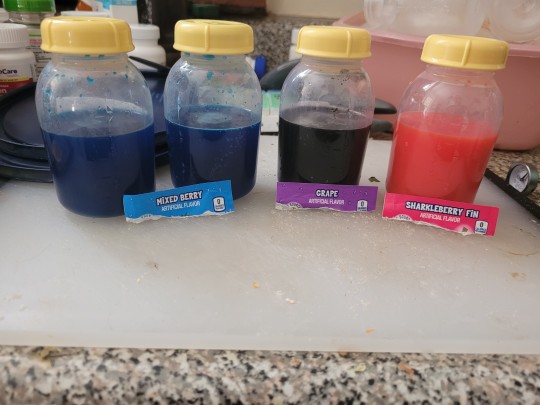
[image ID: four jars of brightly colored liquids, with the torn-off tops of Kool-Aid packets to identify the colors. Mixed Berry is dark blue, Grape is almost black, and Sharkleberry Fin is a salmon pink.]
Here's what my "stock solutions" look like, dissolved in four oz of tap water. The color you get is based on the ratio of powder to fiber, and I'm aiming for 1 packet per ounce of wool. Dissolving it like this just lets me mix colors without going off that ratio or messing around with partial packets.

[image ID: on a stovetop, two hanks of white yarn each sit in a clear Pyrex bowl of water. Next to each bowl is a clear plastic jar with some amount of Kool-Aid mix in it. The jar on the left is very dark blue; the jar on the right is muted purple.)
(Please ignore my gross stove.)
While i was mixing the kool aid, my fiber was soaking to get it really, really wet, which helps to get an even color. The jars next to each bowl are my mixed colors - 1:1 blue to purple on the left, and 1:3 blue to pink on the right. I've got another bowl that's going to be just blue.

[image ID:three Pyrex bowls of yarn and dye arranged on a stove top. Two of the bowls are full of blue dye and one is full of purple dye.]
Here is what the bowls of dye look like when it's first added. I'm using microwave safe containers (pyrex) because besides the acid, this method also requires heat - courtesy of my microwave, which is not pictured because it's even grosser than the stove. I take turns zapping each bowl for two minutes at a time, checking in between to see whether the dye has exhausted.

[image ID: purple yarn in a Pyrex bowl full of water. The water is slightly milky but contains no trace of purple.]
This is what I mean by "exhausted". All the color has been absorbed by the yarn, and the water that was purple now looks milky/clear. If you use too much dye (=too many packets of Kool Aid at once) the bath will never exhaust. The blues took longer than the purple to exhaust, but they all were done after about 5-7 microwave rides.

[image ID: a Pyrex bowl of blue yarn sitting in water. The water is still faintly blue, but far less so than it started out.]
Here's the almost exhausted blue mix. Notice how the cotton twine I used to tie up my hanks is still white? I let this one cool with a bit of color still in the water just because I didn't want to boil it (that gets you felt).

[image ID: three hanks of yarn arranged in a metal colander. The one on the right appears vivid turquoise; the one on the left is a more muted teal; the one in the middle is a dull pinkish purple.]
Once they cooled, I transferred the yarns to a colander to rinse out any kool-aid residue and drip dry. At this point, my kitchen smelled like hot kool-aid, or possibly hair-flavored Twizzlers.

[image ID: three hanks of yarn hanging from hooks on a towel rack. They are turquoise, teal, and purple from left to right.]
Here's what the dried hanks look like hanging up in my bathroom. The one in the middle was the blue-purple mix, while the one on the left was a whole packet of blue on .7 ounces of yarn, so slight more saturated. The purple doesn't photograph well, especially next to the other two, but it’s a muted violet-gray shade.
So that's kool aid dying! You can use this to dye white yarn or fabric, or to overdye other colors. This page from the Wayback Machine gives a lot of good tips on how to combine colors, though some of the flavors are out of date. (No sharkleberry, for instance.)
103 notes
·
View notes
Note
Hey Maya! Today I am wearing your white hands skirt and I really love it but have been contemplating making some changes to it. Of course it's my item and I can do what I want, but I was curious to hear your opinion on what would look best and also how to best honor your art! Since it is a white blank canvas, I was thinking I could either a) tie dye it or b) use fabric markers or something to color each hand a different color (bright colors not like skin tones). I also am not sure whether to do full rainbow for either option or choose 3-4 colors and create a color scheme.
What do you think I should do? And/or what do your followers think if people wanna comment :)
Thanks so much for your beautiful art!!
that sounds so cool! i think what you do should follow both what you have the time to commit to (i think filling the hands in individually would be quite time intensive) and also what you think you will personally wear.
the first step is to see what pigments would take hold on the fabric. the shirts use a synthetic fabric so not all types of pigment will adhere to them (for instance if you were regular dyeing the shirt you'd need to use dye meant for synthetic fiber).
i guess second step is to take a look at the sort of clothing you like to wear and figure out which of those options will best suit your favored bottom garments. after that i'd make sure that the color from the fabric markers was transparent and not opaque, because if it's opaque it will color over the printed lines and that will make coloring the hands in much more tedious.
31 notes
·
View notes
Text
This deep pink colour is from an old jar of Otto Ebeling dark madder (krapplack-dunkel) I inherited. I'm pretty sure it's alizarin PR83. I've got a sample of Kremer's alizarine crimson PR83 pigment, so I'm making up a little of each to compare them. Then we'll see how they both look side by side!
Alizarin has been used for hundreds of years as a pigment, and used to be extracted from madder plant roots. In the 19th century it became the first natural dye to be reproduced synthetically. Today you can buy both synthetic and plant-derived madder pigments. Some people prefer quinacridone pigments that are more light-fast - and I do use those for commission work. But I also have a soft spot for madder & have paints with both plant-derived and synthetic alizarin in. So it's pretty cool to be making my own now 😊
#watercolour paint#paint#watercolor#handmade watercolour#handmade watercolors#watercolour#handmade#handmade paint#paint making#paintmaking#paint mixing#paint mulling
37 notes
·
View notes
Note
Based on your research, do you have any headcanons for the unknown tattoos of important yakuza characters? Like Kazama/Kashiwagi/Arakawa/etc.
I am unsure whether a simple or full tattoo would be best for these characters, so I have given an idea for both the main subject and a flower/plant motif for each. Keep in mind these are just some ideas, some of which are unlikely, but I thought were fun. I would love to hear other peoples’ thoughts on tattoo possibilities.

Arakawa Masumi
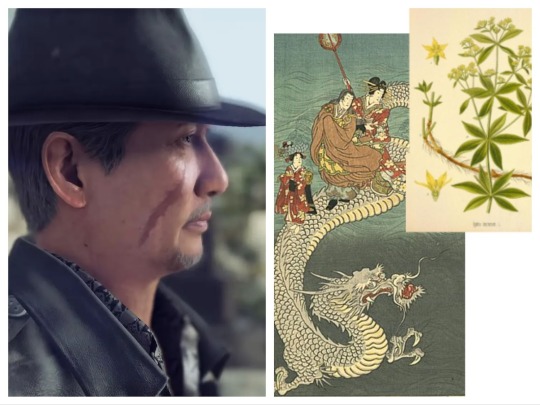
Based on Ichiban and Jo's dragonfish tattoos, which the creators have said are in honor of Arakawa, I feel like a dragon is likely. However, something related to his history as an onnagata (male actor specializing in female roles) in his family's Taishu Engeki troupe is also a possibility.
Maybe the Dragon King Ryujin and one or more of his daughters? This would also play into Arakawa's role as a father to Ichiban and Masato, as well as the rest of the men in his family.
As for a plant, the woman Arakawa fell in love with was named “Akane,” which is the name for a plant (Rubia cordifolia- “Common/Indian Madder”) whose roots are used to make a deep red pigment used in paints and dyes (Alizarin crimson is a synthetic version of Akane red). The plant itself is not an ornamental, so it would make for a unique addition.
Kashiwagi Osamu

I feel like something that reflects Kasiwagi's role as an advisor would be a good choice. Yatagarasu comes to mind- a gigantic 3-legged crow (yatagarasu means "8-span crow" 8 "span" = 144cm or about 4'8") sent by the sun goddess Amaterasu to guide the first emperor, Jimmu, to Japan. The 3 legs are said to represent heaven, earth, and humanity as well as wisdom, benevolence and valor.
Kashiwagi is one of the first characters to "rise from the dead" long after supposedly dying, so a little something to foreshadow that would be good. Wisteria, Chrysanthemums, and peach blossoms are all used to symbolize immortality, so one of those would be a good choice. I went with wisteria for the eyecatch image simply because I like it.
Kasama Shintaro

Kasama really gave me some hell choosing a main subject for a tattoo. He's a very important character to the Kiryu saga, who leaves a lasting impression on the series as a whole.
I settled on Jizo, a popular god in Japan who takes on dozens of forms to protect people against everything from childbirth to headaches. (There are several Jizo statues in the games, namely 5 and 6) He is most well-known as a protector of children, as he helps guide them to the afterlife, but he also takes on the wounds of warriors, watches over travelers. He also acts as defense when the dead are judged, and oversees the punishments in hell so as to ensure they are not too severe, taking on the pain of the sufferers. He is commonly portrayed as a portly, child-like figure, but can also be depicted as a man in monk's robes. Jizo is said to take on the wounds and suffering of others, and Kazama dies shielding Haruka from harm.
A sunflower motif would make sense, given the orphanage he created. Though originally from the Americas, sunflowers were introduced to Japan during the Edo period. Sunflowers symbolize adoration, loyalty, and longevity. They are also known for their unique ability to remove toxins like lead, arsenic, and uranium from soil. The Sunflower Orphanage was built as penance for the murders Kasama has done as a yakuza assassin.
#askrggt#yakuza#ryu ga gotoku#yakuza games#tattoos#irezumi#rgg#yakuza 0#yakuza 7#yakuza 1#yakuza 2#osamu kashiwagi#yakuza 3#arakawa masumi#kazama shintaro#head canon#like a dragon
131 notes
·
View notes
Text

Safely removing nanoplastics from water using 'Prussian blue', a pigment used to dye jeans
Plastic waste breaks down over time into nanoplastics (<0.1 μm). Microplastics smaller than 20 μm cannot be removed in currently operating water treatment plants and must be agglomerated to a larger size and then removed. Iron (Fe) or aluminum (Al) based flocculants are used for this purpose, but they are not the ultimate solution as they remain in the water and cause severe toxicity to humans, requiring a separate treatment process.
Dr. Jae-Woo Choi of the Center for Water Cycle Research at the Korea Institute of Science and Technology (KIST) has developed an eco-friendly metal-organic skeleton-based solid flocculant that can effectively aggregate nanoplastics under visible light irradiation. The research was published in Water Research.
Prussian blue, a metal-organic frameworks-based substance made by adding iron (III) chloride to a potassium ferrocyanide solution, is the first synthetic pigment used to dye jeans a deep blue color and has recently been used to adsorb cesium, a radioactive element, from Japanese nuclear plant wastewater.
Read more.
38 notes
·
View notes